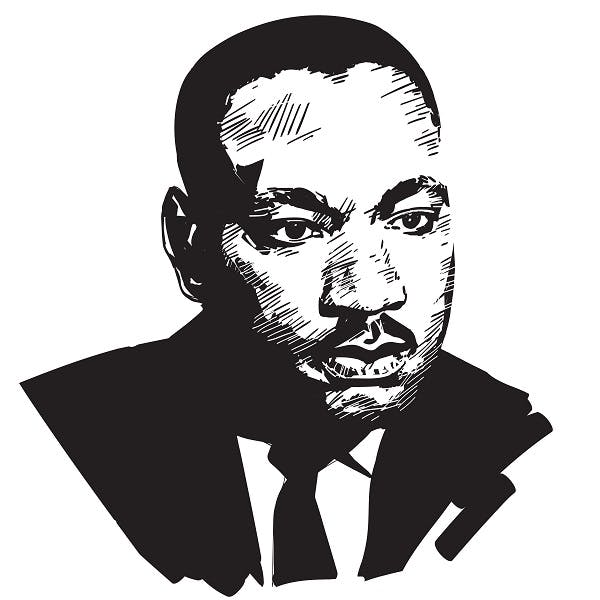While his home was some 2,200 miles from here and most activities as a civil-rights leader were on the other side of the country, Rev. Dr. Martin Luther King Jr. left an indelible mark on Seattle.
His connections to our region are limited but truly memorable. At age 32, Dr. King came to Seattle once – spending three nights here in November 1961 – where he visited locations from the University District to the Central District.
Dr. King came by invitation from Rev. Samuel B. McKinney, at the time a young, influential pastor at Mount Zion Baptist Church (1634 19th Ave., Central District). The two were classmates at Morehouse College in Atlanta, Dr. King’s hometown.
Even while Seattle was seen as more tolerant and liberal-minded than other parts of the country, our city’s African-American population experienced widespread discrimination, as The Seattle Times reported then, including segregated cemeteries and bias in employment and housing. Dr. King’s visit was controversial, with some parents of Garfield High School students protesting to the school board about having a pastor addressing their children.
Dr. King arrived in Seattle on the night of Nov. 8, 1961 and stayed at the Olympic Hotel (now the Fairmont Olympic Hotel). His itinerary was full starting the next day. It included talks in front of a lunchtime crowd of about 2,000 students in old Meany Hall on the University of Washington campus. His evening included a lecture at Temple de Hirsch in the Central District followed by a visit with friends who lived in the area. (Both the UW hall and Jewish temple have since been demolished in favor of larger structures.)
Nov. 10 was even busier. It kicked off at Garfield High. Because the gymnasium was small, Dr. King gave his speech twice to ensure all students and faculty could hear and see the great civil-rights leader. Rev. McKinney remembers the moment, telling The Seattle Times: “He did a motivational talk to the young people at Garfield, exhorting them to make something of themselves and their lives.”
Dr. King then visited Seattle’s Eagles Auditorium (now home to ACT Theatre, 1416 7th Avenue, downtown), where he gave a lecture on the struggles of common people in the South. The building was packed, the Times reported, with King telling the audience: “The nation and the world stand on the threshold of a new age, the age when men of all races will go hand in hand.”
A small contingent – including Dr. King and Rev. McKinney – finished the day eating at Mitchell’s Bar-be-cue (formerly in the Central District), where they stayed into the wee hours of the morning sharing stories and jokes (and apparently trying almost every item on the menu). Dr. King returned to the hotel so late that he missed his 8am flight back to Atlanta.
Rev. McKinney recalled Dr. King’s visit when he told the Times: “He came away singing our praises. He was impressed by the progressive attitude he saw in the city, especially in the African-American community.
“His visit left a good feeling in the community. People were excited, motivated, turned up, ready to take the world on. It had that kind of effect.”
Rev. McKinney also told the Times that this visit was the last time Dr. King would travel alone. “His schedule never permitted him to return, and I guess he had to go where the heat was the hottest.”
Through his life as a non-violent, civil-rights advocate, Dr. King was often followed, threatened and even assaulted. He survived a knife wound to the chest in New York City. His death to an assassin’s bullet in April 1968 was a terrible time in this nation’s history and, yet, it was the spark to new initiatives and legislation that would bring fairness and justice to many people of color in our country.
The House of Representatives approved the U.S. Fair Housing Act one week after the assassination. It went much further than previous Civil Rights Acts, making it illegal to discriminate on the basis of race, color, religion, sex, national origin, disability or familial status in the sale and lease of residential property or vacant land. The law also prohibited discrimination in advertising, lending, real estate brokerage and other services connected to residential real estate.
Churches across Puget Sound hosted special prayer services after the death of Dr. King, with local leaders issuing messages “to help white people understand the need of open housing, integrated schooling, financial aid and ‘most importantly’ the aspirations of black people,” the Times reported at the time. Notably, it was another seven years until Seattle City Council passed its own fair-housing ordinance.
The U.S. marks the Jan. 15 birthday of Dr. King with a national holiday on the third Monday of January. Seattleites hold an annual celebration around the same time in which community leaders, King County employees and others join in honoring the civil-rights leader.
What many people may not realize is the holiday is also a time to dedicate oneself to helping others. King Day of Service, as it is officially known, is aimed to transform the holiday into a day of citizen action and volunteer service. President Clinton signed the proclamation into law in 1994. Thousands of people under the direction of hundreds of volunteer centers participate in activities across the country.
Dr. King was a man of service and his day should be a day of service. The 4 ½-acre park in the Mt. Baker neighborhood named for Dr. King includes plaques with excerpts from his speeches and writings. One comes from his book “Strength to Love”:
“One of the most agonizing problems within our human experience is that a few, if any, of us live to see our fondest hopes fulfilled. The hopes of our childhood and the promises of our mature years are unfinished symphonies.”
Dr. King departed this world far too soon, leaving many symphonies unfinished. It’s up to us to help continue his promises and fulfill ours as well.




